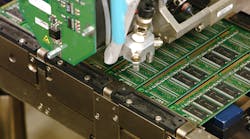Since 2005, Intel has partnered with Micron on the development and manufacturing of flash memory chips. But the company said that it is finally shutting down that part of the partnership, though it will continue to manufacture its new 3D XPoint technology at Micron’s factory in Lehi, Utah.
Currently, the two companies have started to fabricate chips based on their second generation of 3D NAND technology, which stacks 64 layers of circuitry to increase the amount of storage space, twice as thick as the previous generation. The companies will stop collaborating after finishing their third generation of 3D NAND, which is expected to have 96 layers. It is expected to be finished by the end of this year or early 2019.
“Intel and Micron have had a long-term successful partnership that has benefited both companies, and we’ve reached a point in the NAND development partnership where it is the right time for the companies to pursue the markets we’re focused on,” said Rob Crooke, senior vice president of Intel’s non-volatile memory solutions group, in a statement.
Intel inserts its chips in solid state drives for data centers and corporate servers, almost all of which also contain Intel’s computer chips. Micron markets its memory chips for smartphones and laptops, though it has been reshaping its executive ranks to target enterprises and connected cars. It also sells NAND to original equipment manufacturers.
Both companies have also amassed manufacturing might to combat shortages that have spiked prices for memory chips. For the last two years, Intel has been converting its semiconductor plant in China to make memory chips, which could cost it between $3.5 and $5.5 billion. Last year, Micron expanded its 3D NAND fab in Singapore at an estimated cost of $4 billion.
This is not the end of Intel’s partnership with Micron. Both companies will work together to develop and manufacturing their new 3D XPoint technology, akin to a hybrid of DRAM – which can be accessed faster but is wiped clean after losing power – and NAND – which can saves information after losing power but operates slower than DRAM.
In November, the companies finished an addition to the Intel-Micron Flash Technologies plant in Utah, which focused exclusively on the production of 3D XPoint chips. Both Micron’s Quantx and Intel’s Optane products are built by stacking thin columns of memory in a three-dimensional crosshatch pattern, so that the cells can be written and read individually.

